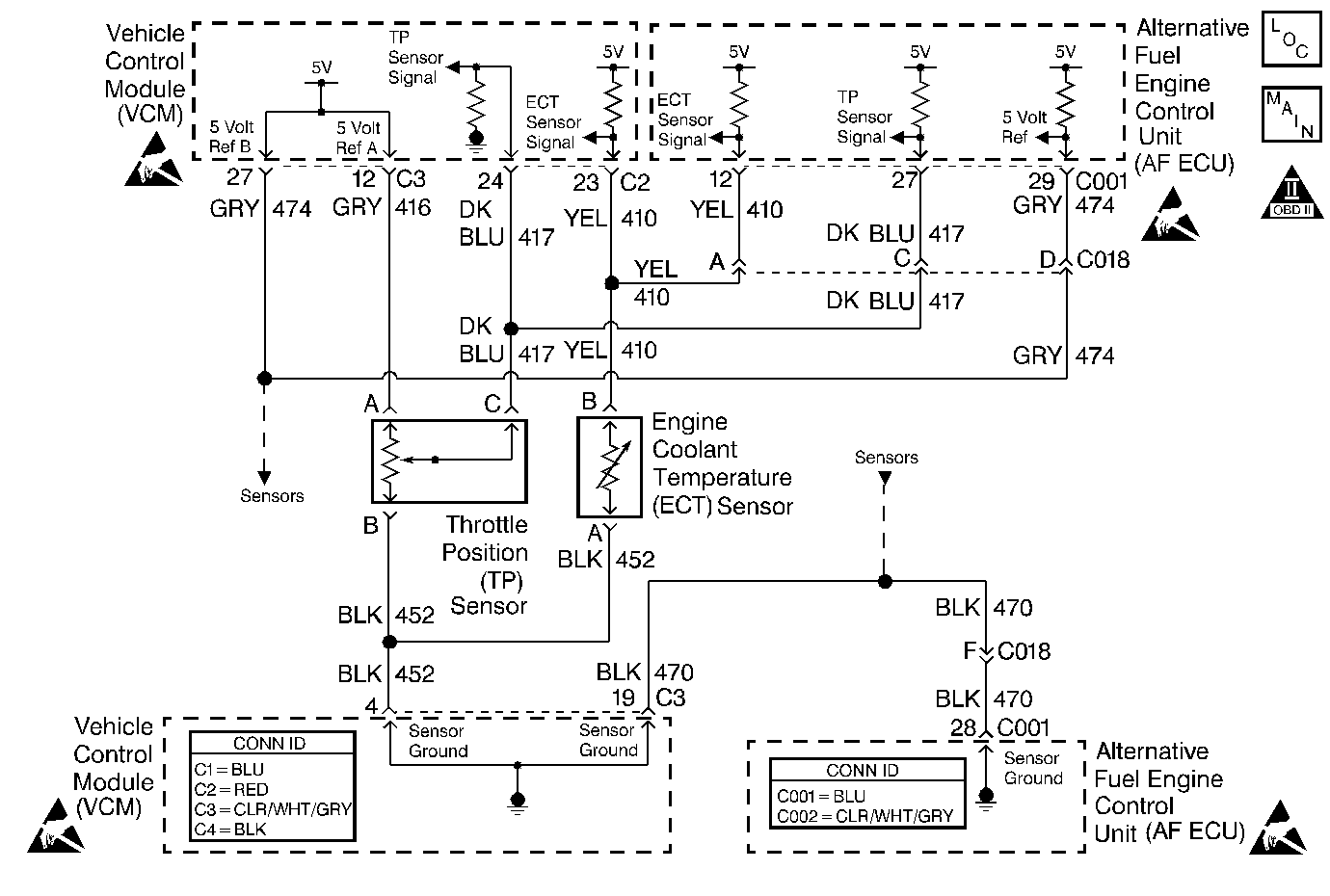
Circuit Description
The Engine Coolant Temperature (ECT) sensor is a thermistor. The ECT thermistor has high resistance when cold and low resistance when hot. The gasoline Control Module (VCM / PCM or ECM) supplies about 5 volts on the ECT signal circuit. The gasoline Control Module also supplies a ground circuit to the ECT sensor. When ECT resistance is high (cold sensor) the ECT signal voltage remains near the supplied 5 volts. As the ECT sensor warms and resistance drops, more signal circuit voltage is pulled lower to the sensor ground. The gasoline Control Module and the AF ECU monitor the ECT signal circuit voltage in order to determine the engines temperature.
This DTC is used to indicate an engine coolant temperature that is less than the temperature necessary to enable AF ECU Closed Loop fuel control.
Conditions for Running the DTC
| • | The engine is operating on alternative fuel. |
| • | AF ECU DTC's P0112, P0113, P0117 or P0118 are not set. |
| • | This DTC has not tested this ignition cycle. |
| • | The engine has been operating for greater than 8.5 minutes. |
| • | The vehicle speed is greater than 5 MPH. |
| • | Desired Gas Flow is greater than 0.5 grams per second. |
| • | The Intake Air Temperature is greater than -15°C (5°F). |
| • | The engine coolant temperature at engine Start-Up is between -17°C (1°F) and 33°C (91°F). |
Conditions for Setting the DTC
The AF ECU monitors an engine coolant temperature that has NOT increased above the Start-Up temperature by 25°C (45°F).
Action Taken When the DTC Sets
| • | The AF ECU will illuminate the MIL and store the DTC as History during ONE drive trip in which the diagnostic runs and fails. |
| • | The AF ECU will record operating conditions at the time the DTC sets. This information will be stored as Freeze Frame data. |
Conditions for Clearing the MIL/DTC
| • | The Last Test Failed status will clear when the DTC runs and passes. |
| • | The AF ECU will turn OFF the MIL after 3 consecutive drive trips that the DTC runs and passes. |
| • | The History status will clear after 40 consecutive WARM-UP cycles with NO failures of ANY DTC. |
| • | All DTC Information can be cleared using a scan tool. |
| • | Interruption of Control Module (AF ECU / VCM / PCM or ECM) power or ground MAY clear DTC Information. Clearing DTC Information with this method is inconsistent and should not be performed. |
Diagnostic Aids
The most likely cause of this DTC is an improperly operating engine coolant system and thermostat. Go to Thermostat Diagnosis in the Engine Cooling section of the gasoline service manual in order to verify proper cooling system and thermostat operation.
Fault Not Present
Fault Not Present indicates the condition that caused the DTC to set is intermittent and not currently present. Refer to Intermittent Conditions Symptom diagnosis for additional information. If any additional DTCs were stored proceed to the applicable DTC table in the order stated in the OBD System Check.
Test Description
The number(s) below refer to the step number(s) on the diagnostic table.
-
Ensure that the engine can reach proper operating temperature in a timely manner before continuing with ECT sensor diagnosis.
-
This step determines if the AF ECU can monitor an open ECT Signal circuit (high voltage).
-
This step determines if the AF ECU can monitor a shorted ECT Signal circuit (low voltage).
-
This step determines if the ECT sensor is accurately monitoring engine coolant temperature.
Step | Action | Value(s) | Yes | No |
|---|---|---|---|---|
1 | Did you perform the AF Powertrain On-Board Diagnostic (OBD) System Check? | -- | Go to Alternative Fuels (AF) Powertrain On Board (OBD) System Check | |
Verify proper cooling system and thermostat operation. Refer to Thermostat Diagnosis in the Engine Cooling section of the gasoline service manual. Was a cooling system repair made? | -- | |||
Does the ECT Sensor data parameter indicate ECT voltage greater than the specified value? | 4.9 volts | |||
Connect a 1 amp fused jumper between the ECT sensor connector Signal and Ground circuit terminals. Does the ECT sensor data parameter indicate ECT voltage LESS than the specified value? | 0.019 volts | |||
Caution: To avoid being burned, do not remove the radiator cap or surge tank cap while the engine is hot. The cooling system will release scalding fluid and steam under pressure if radiator cap or surge tank cap is removed while the engine and radiator are still hot. Does the ECT Sensor data parameter indicate a temperature near the actual engine coolant temperature? | -- | |||
6 | The fault is not present. Refer to Diagnostic Aids. Are any DTC's stored that have not been diagnosed? | -- | Go to the Diagnostic Trouble Code (DTC) List | Go to Intermittent Conditions |
7 |
Was a wiring or terminal repair made? | -- | ||
8 |
Was a wiring or terminal repair made? | -- | ||
9 | Replace the ECT sensor. Refer to Engine Coolant Temperature Sensor Replacement in the Engine Controls section of the gasoline service manual. Is the replacement complete? | -- | -- | |
10 |
Is the replacement complete? | -- | -- | |
11 |
Did this DTC RUN and PASS? | -- | System OK |
